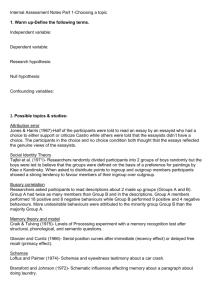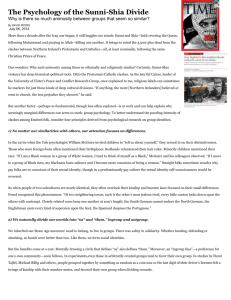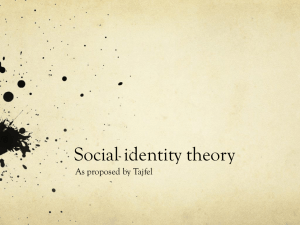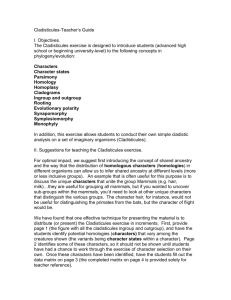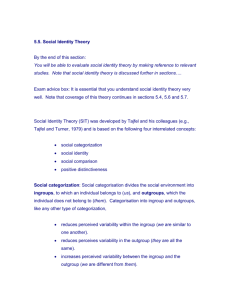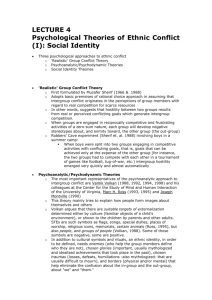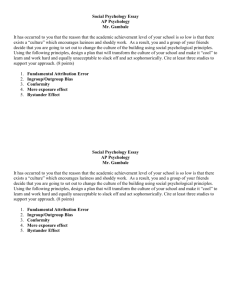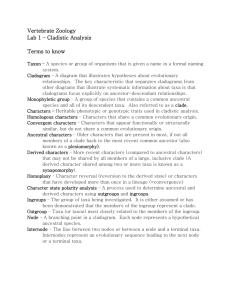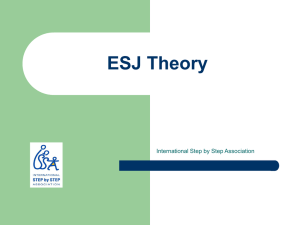Status dilferentials and intergroup behaviour'
advertisement
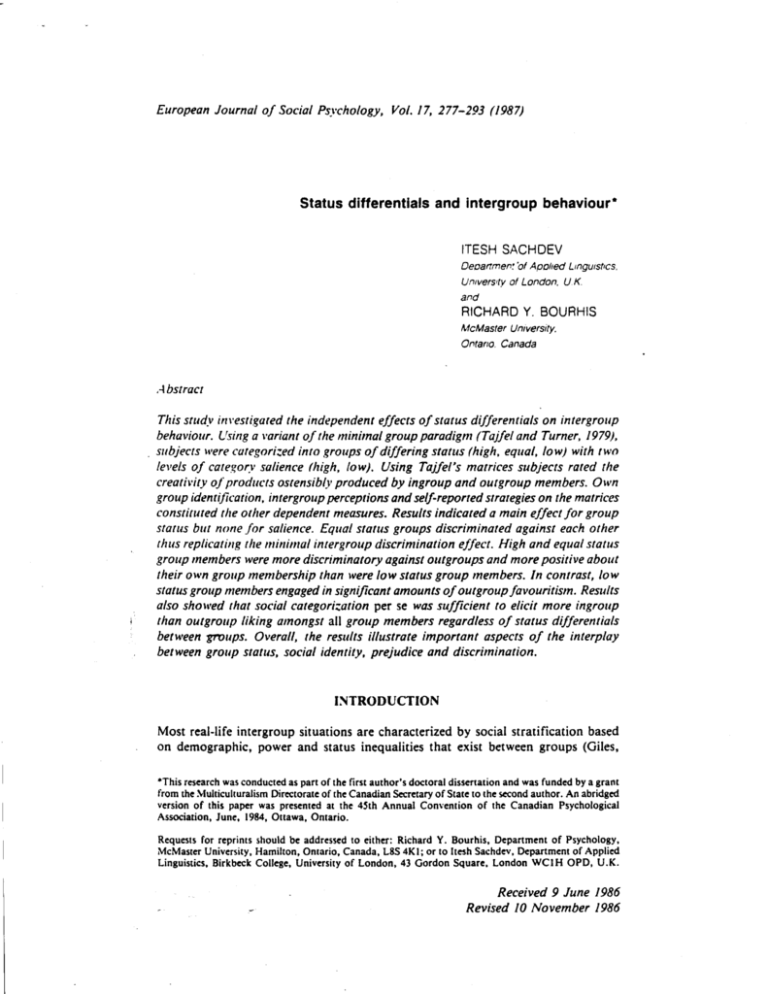
European Journal
of
Social Psl,chology, Vol.17, 277-293 (1987)
Status dilferentials and intergroup behaviour'
ITESH SACHDEV
Deoartmen:'of Apolred Ltngusttcs,
UnMestv ol London, U K.
and
RICHARD Y. BOURHIS
McMaslq University,
Ontano. Canada
.lbstract
This study invesrigoted the independenr effects of sratus differentials on intergroup
behaviour. Lrsing a vdriant of the ntinimal group paradigm (Tajfel and Turner, /,979),
subjects were cutegorized into gtoups of differing status (high, equa!, Iow) with two
levels of catesory solience ftigh, low). Using Tajfel's matrices subjects rated the
creativity oJ'products ostensibly produced by ingroup and outgroup members. Own
group identification, intergroup perceptions and self-reported strategies on the matrices
constituted the other dependenr measures. Resa/rs indicated a main effect for group
status but none for salience. Equal status groups discriminated against each other
thus replicating the minimal intergroup discrimination e/fect. High and equalstatus
group members were more discriminatory against outgroups and more positive about
their own group mentbership than were low status group members. In contrast, Iow
status group members engaged in signiJicont amounts of outgroup favouritism. Results
also shorsed that social categorization per se was sufficient to elicit more ingroup
than outgroup liking amongst all group members regordless of status differentials
belween gvoups. Overall, the reshs illustrale important aspects of the interplay
between group status, sociol identily, prejudice and discrinination.
INTRODUCTION
Most real-life intergroup situations are characterized by social stratification based
on demographic, power and status inequalities that exist between groups (Giles,
'This research was conducted as part of thc first aurhor's doctoral dissenation and was funded by a grant
from the lvlulticukuralism Drectoratc of rhc Canadian Sccreury of State ro the sccond author. An abridged
version of this paper was presenred at rhe 45th Annual Convention of thc Canadian Psychological
Associarion, June, 1984, Ottawa, Ontario.
Requests for reprints should be addressed to either: Richard Y. Bourhis, Depailment of Psychology,
McMaster Univcrsity, Hamilton, Ontario, Canada, LES 4Kl; or to ltesh Sachdev, Departmcnt of Applicd
Linguistics, Birkbeck College, Universiry of London, 43 Gordon Square, London WCtH OPD, U.K.
Received 9 June 1986
Revised I0 November 1986
278 I. Sachdev and R. Y. Bourhis
Bourhis and Taylor, 1977). However, experimenral social psychology has largely
ignored the systematic investigation of sociosrructural variables such as group
numbers, power and status differentials on intergroup relations. As one of a series
of studies investigating each of these sociostructural facrors (Sachdev and Bourhis,
1984, 1985), the present study was designed to assess the impact of srarus differentials
on intergroup behaviour. Our definition of group starus was the relarive position of
groups on valued dimensions of comparison such as educational achievement,
occupation, social standing, speech styles, etc.
Since the seminal results of Tajfel, Flament, Billig and Bundy (1971), a number
of 'minimal group' studies conducted with subjects of different'ages, nationalities,
and sexes using a variety of dependent measures have shown that the mere
categorization of people into two groups is suflicient to induce intergroup
discrimination (e.9. Billig and Tajfel, 1973; Brewer,1979; Tajfel, 1978, 1982a; Turner,
I980). In this research, discrimination refers to the action of favouring members of
the ingroup over members of the outgroup in the distribution of valued resources.
Tajfel and Turner (1979) propose that Social ldentity Theory (S.l.T.) provides the
most tenable explanation for minimal group discrimination. Social idcntity refers ro
'those aspects of an individual's self-image that derive from the social categories to
which he perceives himself as belongingl (Tajfel and Turner, 1979, p. .10). In its baresr
essentials, Social Identity Theory (S.I.T.) suggests that in many intergroup situations,
people seek positive distinctiveness for their own group to protect and enhance their
self-esteem (see also: Tajfel, 1982b; Turner and Ciles, l98l: Turner, Hogg, Oakes,
Reicher and Wetherell, in press). Thus, in the traditional minimal group experimenrs,
it was not minimal social categorization that caused discrimination but rather thar
motivations for positive self-evaluation could only be achieved by using the
experimentally imposed categorizations in a discriminarory fashion (see Turner, 1975).
In accordance with this notion, Oakes and Turner (1980) as well as Lemyre and Smith
(1985) obtained results which showed that increased self-esteem was positively related
to minimal group discrimination.
These classic minimal group studies employed groups that were implicitly of equal
status. Of course, real-life intergroup situations with groups of exactly equal status
are rare. Tajfel and Turner (1979) claim that group status has a porverful impact
on the social identities and intergroup. strategies of group membcrs. Through
unfavourable comparisons with outgroups, low status confers a negative social identity
and can constitute a threat to self-esteem. Horvever. to the degree that low status
group members acknowledge the superiority of high status group members on the
status-related dimension of comparison, S.I.T. predicts that low status group members
will show outgroup favouritism rather than ingroup favouritism (discrimination)
towards high status outgroups. Conversely, high status confiers a positive social idenriry
as it implies favourable comparisons vrs-ri-vrs low status outgroup members on relevant
dimensions of comparison. Thus, on the comparison dimensions that are consensually
perceived in favour of the high status group, S.I.T. predicts that high status group
members will discriminate against low status outgroups.
Laboratory studies investigating the link between group status, social identity and
intergroup discrimination have yielded contradicrory results. For instance, studies
conducted by Tajfel et al. (1971) and Commins and Lockwood (1979) employing
almost identical manipulations of high/low group status produced inconsistent results.
Whereas the former study found no differences in discrimination betrveen high and
Status dilferentials and intergroup
behaviour
279
low status groups, results from the latter study suggested that discrimination increased
rvith status. Commins and Lockwood's (1979) results were supported in a study by
Doise and Sinclair (1973) who found that high status group members discriminated
more than low status group members. In addition, low status group members in the
Doise and Sinclair (1973) study appeared to favour members of the outgroup rather
than members of their own group (i.e. displayed outgroup favouritism). In contrast,
Branthwaite, Doyle and Lightbown (1979) found that low status group members were
more discriminatory than high status group members. Results of a complex, though
statisticallv tenuous stud-v b_v Turner and Brown (1978) were also'at variance with
the other studies cited above. They suggested that high status groups did not
discriminate rvhen their superiority was perceived to be completely secure, However,
as in the Doise and Sinclair (1973) study, low status group members did display
outgroupfovouritisnt when allocating points to high status outgroups for status-related
performancc under legitimate and stable intergroup status conditions.
Further evidence suggesting that high status groups often benefit from favourable
outgroup responses.lvas recently obtairted in a complex study by Brown and Abrams
(1986). Amongst the results obtained in this study it was found that individuals
categorized as group members showed less evaluative bias against high status
outgroups thln against los' status outgroups. Finally, in a series of studies investigating
the personal and group social comparison strategies of high and lorv status groups,
Rijsman (1983) found that high status group members systematically outperformed
lorv status outgroup members as the former sought to establish that their personal
level of performance was commensurable with their high status group ascription (for
studies on personal versus group status reward allocations see Ng 1985, 1986).
Differences in subject samples, status operationalizations and dependent measures
may well account for some of the discrepancies noted in the above studies. ln addition,
although in previous studies both high status group membership and discriminatory
behaviour were supposed to provide group members with a positive social identity,
these laborarory studies did not direcrly assess the hypothesized links between status,
social identity and discrimination. Funhermorer status manipulation checks have either
not been successful (e.g. Branthwaite et al.,1979\ or have not been employed (e.g.
Commins and Lockwood, 1979). lndeed, neither Tajfel et al. (l91ll nor Commins
and Lockwood (1979) included reference to social 'prestige'or 'status' in their
instructional sets, or evaluated the importance that subjects attached to the status
dimensions used in the experiments. Finally, recent conceptual attempts to resolve
the above discrepancies have been mainly of a post Aoc nature (e.g. Van Knippenberg
and Wilke, 1979; van Knippenberg, 1984).
It was the equivocal nature of laboratory research on intergroup status differentials
that provided the impetus for the present study. The three major aims of the study
were: (a) replicarion of rhe traditional minimal group results; (b) investigation of the
effects of status differentials on intergroup behaviour; (c) examination of subjects'
perceptions of, and responses to, the experimentally imposed status categorizations.
Perceptions of relative status were established by dividing subjects into two groups
on the basis of false performance feedback on a creativity test. Subjects were
specifically informed that one's creativity was positively related to one's social status.
Subjects were then asked to rate products ostensibly created by other ingroup and
outgroup members using special matrices developcd by Tajfel and his colleagues (see
Turner, Brown and Tajfel, 1979).
280
I.
Sachdev ond
R. Y. Bourhis
Several methodological criteria were fulfilled to enable the assessment of the
independent effects of status differentials on intergroup behaviour and perceptions.
Subjects neither faced an intergroup conflict over scarce resources nor had the
opportunity to engage in direct self-interested actions. Croup memberships were kept
anonymous and Tajfel's matrices provided subjects with a variety of response
strategies including outgroup favouritism, parity, maximum joint profit, maximum
ingroup profit and maximum differentiation. Unlike mosr previous minimal group
studies the present research supplemented Tajfel's matrix allocations with subjects'
self-reported allocation strategies.
S.l.T. suggests that subjects in the traditional minimal groups'(implicitly of equal
status) fulfilled their motivations for a positive social identity by establishing
favourable intergroup comparisons (i.e. discriminated) on the only avarlable dimension
of comparison-Tajfel's matrices (see Turner, 1975). In the present srudy, the results
of a stable and legitimate creativity test (bogus) was used as the status dimension
to categorize subjects into equal or unequal status group members. On rhe basis of
this,' Hypot&esis /' was formulated thus: .subjectv'categorized, as members of equal
status groups would positively differentiate themselves from outgroups on available
dimensions of comparison through the use of discriminatory strat€gies on the Tajfel
matrices.
Our expectations concerning the effects of high and low status were derived from
S.I.T. and the discussion above. In the present study, both high and low status group
members were given an opportunity to rate the creativity of ingroup and outgroup
products using Tajfel's matrices. However, creativity was the very dimension that
a credible, prestigious and persuasive experimenter had used to establish the only
existing status difference between the two groups. Therefore, it was expected that
in order to assert their superiority on status-related dimensions, high status group
members would show greater discrimination (i.e. ingroup favsuritism) rhan low srarus
group members (hypothesis 2\.
Hypothesis J was formulated on the premise that low status group members did
accept the grounds for establishing the status differentials as being legitimate and
stable. To the degree that this was so, low status group members were expected to
show outgroup favouritism towards high status groups as an acknowledgement
of their 'inferiority' on the existing status-relared dimensions of comparison
(hypothesis 3).
Expectations about the intergroup strategies of equal status group members compared
to those of high and low status group members were more complex. The difficulty
in the case of equal and high status groups stems from trying to conceprually predict
the difference between discrimination to achieve and discrimination rc maintain a
positive social identity. Empirically, srudies comparing high and equal status groups
suggest that high status groups are more discriminarory than equal srarus groups (e.g.
Commins and Lockwood, 1979). It is arguably easier for high status group members ro
maintain andlor enchance superiorities on acknowledged dimensions of superiority than
for equal status group members to claim ascendancy on a dimension of comparison where
equality of status has been proclaimed. This is particularly the case when the srarus
equality is provided by a credible experimenter from an established scienrific discipline.
Comparisons of equal and low status group strategies were more straighrforward since
equal status groups were expectd to discriminate as in the usual minimal group studies
while low status groups were expected to show outgroup favouritism.
Status di/ferentials and intergroup
An attempt
behaviour
281
to assess the impact of salient and nonsalient status
categorizations on intergroup behaviour. Previous laboratory studies (e.g. Commins
and Locks'ood, 1979) have generally employed nonsalient manipulations of intergroup
status. Tajt'el (1978) and Brewer (1979) suggested that increasing the salience ofcategorization leads individuals to behave more in terms of their group memberships than in terms
of intra- or inter-individual factors. Previous minimal group studies (e,g. Billig and Tajfel,
1973; Turner, Sachdev and Hogg, 1983) suggested that explicit categorization operationalized by the mere mention of the label 'group' rvas sufficient in eliciting intergroup
discrimination. ln the present study both salient and nonsalient categorizations of the
groups were manipulated. The nonsalient categorization was achieved by only informing
subjects of the relative status of the two groups while the salient categorizadon was created
by explicitly labelling subjects as high, equal or low status groupmem&rs. Accordingly,
it was hypothesized that increasing the salience of status differentials should polarize
patterns of intergroup behaviour present in the nonsalient conditi ons (hypothesis 4).
The third aim of the study was to obtain subjects' perceptions of, and responses
to, the experimr'ntal situation. Civen that such perceptions have rarely been obtained
in previous rninimal group Iaboratory'studies, they were considered to be exploratory.
Of particular interest were measures designed to assess subjects' own group
identifications and intergroup preceptions. As in Sachdev and Bourhis (1985) who
rvas also made
also used estensive post session questionnaires, it was expected that group
categorizatior' per se would be sufficient to promote ingroup liking and outgroup
dislike (prejudice) regardless of the status manipulation.
METHOD
Subjects
Subjects were 120 Introductory Psychology students who volunteered as a partial
fulfillment of their course requirement. All subjects were English-speaking Canadians
between the ages of l8 and 2l who had lived in Southern Ontario for all of their lives.
Design
Subjects were run in group sessions (20 per session), with treatment condition
randomly determined for each session. There were six treatment conditions. Subjects
were categorized into different status groups ostensibly on the basis of their
performance on a creativity test. Half the subjects were exposed to a manipulation
aimed to make their group memberships more salient. The rest were in the nonsalient
conditions. Thesc manipulations yielded a3xZdesign matrix consisting of three levels
of status (high, equal, low) and two levels of salience (NS and S).
Procedure
A
male English-speaking Canadian experimenter introduced the study as an
investigation of aspects related to'creativity in academic settings'. Subjects were
instructed that they would be completing two creativity tests for this purpose. It was
impressed upon the subjects that creativity was an extremely imponant aspect of
intellectual functioning and that it correlated significantly and positively with social
282 I. Sachdev and R. Y. Bourhis
and occupational status both within and beyond the University setting, Subjects were
then asked to complete the first 'quick and often use, srandardized' creativity test
designed to provide an index of their creativiry. This test was adapred from Moscovici
and Paicheler (1978) and consisted of mocimizing rhe number of possible:rrangements
of horizontal bars whilc observing a specific set of rules. lt will suffice to say that
the scoring procedure of this test was made ambiguous enough to prevent subjects
from making realistic estimates of their own creativiry on rheir test. Previous piloting
of this test had shown that subjects found it neirher too difficult nor too easy.
While an assistant busily appeared to score subjects' responses on the first creativity
test, subjects were asked to complete a second creativity test. This consisted of crearing
a series of titles for an abstract print by an unknown artist. Upon completion, subjects
were instructed that the results from the first creativity rest were available. Feedback
(false) about individuals' creativity on the first test was provided by caregorizing
individuals (identified only by personal code-letters) into two groups (group X or
W) on the basis of their creativity performance. Specific instructions manipulating
the status variable \{ere theo given. In the high and lorv starus conditions, subjects
were told that their first creativity scores situated them in one of two groups: rhose
high in creativity and those low in creativity. In the equal status conditions, subjecrs
were told that their scores placed them in one of two equally creative groups that
only differed in the manner in which they completed the test.
For half the subjects, group status \ryas made satient by emphasizing the crearivilystatus link mentioned earlier and by labelling groups in the session explicitly as 'high,
equal or low status'. These subjects were then requesred to rvrite their group
identification labels in their response booklets. The nonsalient lnanipulation u'as
achieved by only informing subjecrs of the relative status of the two groups resulting
from the scores obtained in the first creativity test.
Following these manipulations the experimenter e.tplained that he was also inreresred
in investigating how subjects, themselves, evaluated the creativirl' of others. For this
purpose, subjects were asked to give their personal evaluarions o[ rhe creativity of
other individuals based on their performance on the second crearivity test (i.e. the
titles generated by others). The actual titles they rated were, in reality, consensually
prejudged by 200 other subjccts (from the same popularion) to be equivalent in
creativity. The titles were randomly presented as products of rwo orher subjects who
were identified only by their personal code lerters and rheir respective group
memberships. Subjects, in fact, always privately rated products ostensibly created
by a member of the ingroup (excluding themselves) and a member of rhe oulgroup.
The ratings were completed by using Tajfel's matrices to award points to sets of titles
ostensibly produced by ingroup and outgroup subjects present in the session. Following
the matrix distribution task, subjects compleled a postsession questionnaire. Finally,
subjects were carefully debriefed to mutual satisfaction.
Dependent measures
Matrix ratings
Our main dependent meaiiures were subjects' point-allocations to ingroup and
outgroup individuals using Tajfel's matrices. Four basic strategies can be assessed
using Tajfet's matrices (Turner et al., 1979). Parity (P) represents a choice which
Statrs differentials and intergroup
behoviour
283
arvards Equalnumber of points to a recipient from the ingroup and a recipient from
the outgroup. Absolute ingroup favouritism or profit (MIP) represents a choice which
awards the highest absolute number of points to the ingroup member regardless of
arvards made to the outgroup recipient. Relative ingroup favouritism or maximum
differentiation (NtD) represents a choice rvhich marimizes the dilference in points
awarded to trvo recipients, the difference being in favour of the ingroup member but
at the cost of sacrificing absolute ingroup profit. Maximum joint profit (MJP)
represents a choice rhat maximizes lhe rctal cotnbined number of points to both
ingroup and outgroup recipients. Though there has been some controversy about the
use and scoring o[ these matrices evidence from this study and previous research
indicates that the Tajfel matrices can monitor subjects' social orientations in a valid,
reliable and sensitive manner (see Turner, 1980, l983a,b Brown, Tajfel and Turner,
1980; Bornstein, Crum, Wittenbraker, Harring Insko and Thibaut, 1983a,).
Three matrix types (from Turner et a|.,1979), designed to measure the strengths or
'pulls' of the above strategies on subjects' choices, were used. The first matrix type
compared parit-v (equality, P) versus ingroup favouritism (FAV). Ingroup favouritism
(FAV) was made up of the strategy of ma.nimum ingroup profit (MIP) plus the strategy
of manimum differentiation (lvlD), (i.e. FAV = MIP + tvtD). The second matrix type
compared ingroup tar ouritism (FAV) versus ma,ximum joint profit (MJP). The third
marrlx type compared madmum differentiation (lvtD) versus combined absolute ingroup
profit and marimum joint profit (MIP+ MJP). From each matrix type, two pulls can
becalculated. Each pull has a theoretical range from - 12 to + 12. Negative strategy pulls
indicate pursuit of their psychological opposites, e.g. negative FAV indicates outgroup
favouritism, or the asarding ol more points to a member of the outgroup than to a
member of the ingroup. \,tatrices were randomly presented to each subject. Each matrlx
type was presented once in its original form and once in its reversed form in order
to obtain pull scores. This amounted to six matrix presentations in total. A manual
(Bourhis and Sachder, 1986) describing the Tajfel matrices and explaining the method
used to calculsre 'pull scores' is available from the authors upon request.
Postsession ques I io n naire
Several items on a postsession questionnaire assessed the following: (i) subjects' selfreportd matrix distribution strategies and their estimatc of strategies that other ingroup
and outgroup members employed; (ii) subjects' identification with ingroup, estimates
of other subjects' identification with ingroup and estimates of outgroup subjects'
identification rvith their groups; (iii) subjects' liking for other ingroup and outgroup
members and rheir estimates of other subjects' liking for them and ingroup and
outgroup ottfers; (iv) subjects' feelings about their own group membership including
estimated relative status and power of ingroup and outgroup; (v) subjects' responses
to the oeerimennl situation including the perceived legitimacy of the status differentials.
The above questionnaire items were all answered on seven-point rating scales. Copies
of the postsession questionnaire are available upon request from the authors.
RESULTS
This section is divided into two parts: analyses of subjects' matrix ratings, and their
responses on the postsession questionnaire items.
284 I. Sachdev and R. Y. Bourhis
Analyses of subJects' matrix distribution strategies
Following Turner et al. (1919J and Brown er a/. (1980), 'pull' scores were calculated
for each strategy (see also Bourhis and Sachdev, 1986). Two sers of analyses were
conducted on these pull scores: (a) strategy analyses wirhin each treatment condition;
(b) strategy analyses between treatment conditions.
Strotegy analyses within each trestment condition
I presents the mean pull scores of each strategy for each cell in the design.
These were calculated and tested by performing Wilcoxon Matched Pairs tests on
the difference in scores between the ingroup/outgroup (l/O) an outgroup/ingroup
(O/l) versions of each matrix type. Overall, the strengths of each variable declined
Table
in magnitude in the order of: P on FAV, MD on MIP + MJP, FAV on P, FAV
on MJP, MIP + MJP on MD, and MJP on FAV. To test for anifactual dependence
between any two pulls calculated from the same matrix type, correlations were
calculated between the cell devia.tions of each pull and the absolute cell means of
the appropriate obverse pull (see Turner et al., 19791. No correlations were significant
suggesting that obverse pulls obtained from the same matri.r typc were not artifacrs
of compressed ranges.
Table I shows that the pull of parity (P on FAV) w:rs strong in all conditions. Despite
the strong pull of parity across all conditions, clear and systematic variations in the
use of other strategies emerged. As can be seen in Table l, results from equal status
groups supported hypothesis l. Equal status group members clearly discriminated
by employing significant levels of relative (MD on lvtlP + MJP) and absolute ingroup
favouritism (FAV on P and FAV on MJP).
Support for hypotheses 2 and 3 was also obtained. Whereas high status group
members discriminated a great deal, low status group members showed outgroup
favouritism. The pulls of relative ingroup favouritism (lr{D) and absolute ingroup
favouritism (FAV) were significantly positive in the high status conditions but negative
Table 3. Mean 'pulls' of subjects' matrix distribution srrategies
Low
Status
Matrix
slrategy
Nonsal.
(NS)
P
6.95.t
on FAV
MD
on lvllP + IvtJP
FAV
on P
FAV
on MJP
MIP+MJP
on MD
MJP
on FAV
'p<0.01.
tMean
. Equal
Salicnt Nonsal. Sailient
(s)
(NS)
(S)
-
1.85
-
1.25
-2.ffi'
1.85r
1.00.
E.65.
6.
10.
- I .70
7.0_(.
- 0.25 3.05.
Salient
(S)
X
1.70.
4.60.
6.29
3.6-s.
6.
_<'
5.70.
3. 1 7
3.80.
4.74.
4.7V
2.46
5.50.
4.20'
2.25
4.40.
4.25r
-
0.35
0.55
0.35 0,60
(NS)
6.75r
-2.25'
0.20
High
Nonsal.
0.05
1
t..r0r
0.10 - 0.50
L20
pull score for each matrix distribution stratcgics range from -12 to +12.
rp<0.05.
0.89
0.27
Status CiJferentiais and intergroup
behaviour
285
or not signiiicant in the iorv status conditions. Hon'ever results in Table I also suggest
:hat though \IJP (on F.\V) and \{lP + lIJP (on \1D) *,ere the leasr inilue'ntial
strategies in ihe stud-"-, thcse trvo strategies were adopted to a signiiicant degree by
ncnsaiient low status group members. Finallv, the 'rvirhin' conditions analyses
:ror i..ied lirric sr stemaric support lor hl pothesis -1.
,irrcie?_r' r,'r,,,,t1'se-r ile! v'een t red! nten
t
condit iorts
l,r Setie:-:t..j's n\potltr-'-ses l, -l .;nd J. a status (three levc'ls) b.y'categorl saiience
ii\\o ^e\eis) ;::itiir'.ariatc anair:is.ti rariance,r'as empioved *ith the six matrir puil
iitrr-cS JS i,..rerJenr,Tleasure:. The orerall \1ANOV.{ rercaied onlv a rnain eliect
ior :he staru5 . rnacie. fl i :. : i ) = l :l, p< 0.00l. Unirariare anair':es indrcarcd lhar
tne status nriin ciieci *as sipnliicant ior iour strategies; (i) F..\\ (on \1JP), F(:,
jlJ)=1.i.5J.:'(0.rIl:(iit\lD ron \flP - \lJP), F(], lll)=_11.1-(, p<C tr(')l:(iii)
F\\'16nPl,frl, ll-)=lS ii,r<Ct)01;rrr)P(onFA\'),F(:, t;-l)=-i.0;,p<0.01.
1
Subsequent ;Jmitansons (Duncan's
\lulripie
Range tesi
-
all conlDansons at p < 0.0-,.)
:r'.;i;err'd a ia:ge 11.:',:r-i':'ot -\unnor! ior hl,pothesis 3, supporr ior nvporhesis , bur
....:, i!l-nr.r,
":
F
!
..1. r..,,n,.,-,.J.1s .
-1
ln ac:orian;;' ',r 11x i1r'pctresr-s l. high t.t/= J.85) and equai (.11= l.-11) :itru-s 3raupS
nelnbers di-se:rminaiel .\,, 1i,'piaving higher FAV (on \lJP) rhan lo* i.',/= -:.i:)
:ialLls qroup rncnia.l's. in rddirrcn. htgh (.1/:5.93) and equal (,1/= J.1,5) srarus group
merrbers disc::rnrnale C bv sho* ing grearer ma.rimum diilere nriarion (!lD) rhan low
, 11- - i.-S).tuius group members. \\'hen FAV was pitred againsr P, hig (.11=-i.70)
rnd eouai t.l/ = .J3) status croups \r'er€ also mrrre discriminatory than lorv status
t.\/= -0.15)groups. Hor,,'ever,therewasnoindicationthathighstatusgrouprnembers
disc:iminateC nrore than equal sra(us group members. On all thL.se measures. the
negat!\e sccres oi lorv sratus groups clearly indicated outgroup t'avouritrsm, thus
..) rl.'or:rng 11r;rrtiicsrs i. Tirour:h lll
-zroups shorved large amounts r)l pant\'(P on
F.\\'), lorv struus group members (.1/=7.80) dispiayed more pariry,than high status
group membcrs (.t/= .1.6-5).
Finallv, resulls ol lhe o\erail 3 x 2 \tANOVA provided no support lor hy'pothesis
J. The manipulations aimed to make eategories more saiient did not seem to affect
lnlergroup behaviour ln this exDeriment.
-1
.{nalyses
of
postsesslon questionnaire
Due to the large number of questionnaire items, an overall status by salience
\IANO\'.{ uas conducted on all dependerrt measures. A significant main eflect rvas
obtarned only' ior th€ status variable, F(78, 152) = 5.99, p<0.001. Univariate anai-vses
indicated that thrs main eflect rvas highly significant for itens listed in Tablc 2. As
our salience manipulation did not seem to aflect subjecrs'responses, the results are
presented collapsed across salience of condition. The MANOVA main effect was also
signiiicant for other dependent variables which were more appropriately analysed
by 'repeateC measures' analyses that are reported later.
Results in Table 2 show that high and equal status group members had more positive
feelings associated with their group membership and the status differential than low
status group members. Duncan's l\{ultiple Comparison tests indicated that high and
equal status group members felt more comfortable, satisfied and happy than low status
286 I.
Sachdev and
R. Y. Bourhis
Table 2. Perceptions of group membership and sratus differential (collapsed across salience)
Status
Low
Equal
Variable
Comfortable with group
Hieh
F(status)
43.96, p<0.001
(2, r r4)
2.63b..
4.93..b
5.70
2.20b
2.23b
4.25".b
5.88"
4.29.'b
5.98r
66.62, pco.00t
73.46, p<O.001
creativir!'test
3.0Eb
4.39"
4.23'
Fairness of
categorization
8.69, p<0.001
2.70b
3
.83"
3.93u
9.54, p<0.001
status differential
Personal value of
2.23b
3.85.
3.63a
18.87, p< 0.001
creativity
5. t5d
5.8S
5.78.
3.22, p<0.05
Satisfied with group
Happy with group
Fairness
of
Legitimacy of
fromb at p<0.0t.:'differs from at p<0.05.
highcr the mcan ratingon the 7-point scale, the higher rhe score on rhc item.
d
'differs
'The
group members. Indeed, high status group mem ers were also more positive about
their group membership than equal status group members.on rhese measures. In
addition, high and equal status group members lound the experinrental procedures
for measuring creativity and categorizing subjects to be more agrceable rhan did low
status group members. Table 2 also shows that high and equal starus group members
perceivd the status differential to be more legitimate than lorv srarus group members.
Interestingly, though all subjects valued creativirt, hiehly (all group means over 5 on
a 7-point scale), low status group members seem to undervalue creativity relative to
the other groups (Table 2).
Importantly for S.I.T., a number of items asking subjecrs lo esdmare ingroup
identification (of members of both groups) and 'liking' for members of both groups
were analysed by repeated measures ANOVAS with an o priori significance crirerion
on p<0.001 for each lest. One significant interaction el't'cct rvas
obtained:
status x group identificatior, F(4, 228) =24.80,p < 0.001. Table 3 shows thar the high
and equal status group members showed higher levels of owngroup identification
than low status group membcrs. In addition, low and high srarus members seemed
to have similar expectations about the degree of group identificarion reporred by orher
low and high status group members. Both groups felt that high starus group members
would identify more than low status group members rvith their respective ingroups.
The analyses also revealed repeated measures main effects for the following
imponant intergroup perception measures: (a) subjects' estimated liking for orhers,
Table 3. Subjects' estimates
(collapscd across salience)
Identification by:
Self
Other ingroup
Other outgroup
of ingroup idenrificarion
b;- selt and others
Low
Status
Equal
Hish
3.3ob.c..
3. ggd.b
4.99r
3.4Eb
4.13.r
5.3r
4.65.
{.ld
3.5 5b
'differs from ar p<0.01.;'differs from c at p<0.05.
Thc highcr the mean rating on the 7-poinr scale, thc higher the scorc on rhe item.
b
'
Sratns differentials and intergroup
behaviour
287
f'( I , I l4) = 12.28, p < 0.001; (b) subjects' estirnates of other ingroup members' liking
lor others, F(2,2281=40.29, p<0.001; (c) subjects' estimates of outgroup members'
liking for others, F(2, 228)=25.28, p<0.001. Duncan's pairwise comparisons
indicated that (p <0.01 for all comparisons): (a) subjects would like ingroup members
1,\{ = 4.731more than outgroup members (M = 4.27). (b) subjects also felt that other
ingroup members would like them (M4.88) and other ingroup members (M=4.80)
more than outgroup members (r|fa.03); (c) subjects estimated that outgroup members
n ould like other outgroup members (M = 1.92'l more than themselves (.1/ = 4.27) and
orlrer members of the ingroup (.1/=.1.12). Thus social categorization per se was
sufficient in eliciting more ingroup than outgroup liking amongst all group members
regardless of status diflerentials between groups.
Results of manipulation checks revealed that all subjects agreed that highly ceative
people had higher status (M=5.55) than rhose low in creativity (i,/=3.33), F(1,
I l.r) = 196.6l, p< 0.001. These perceptions did not seem to be differentially affected
b:- the status or salience manipulations. A repeated measures ANOVA (status x
saliencexingroup/outgroup) on subjects' reported perceptions of ingroup and
oulgroup status revealed a significant status by repeated'measures interaction (F(2,
I lJ) = 19t4.63. p<0.001). Duncan's lVtulriple Comparison tests showed that all groups
accurately perceived the status differentials imposed in the experiment. Indeed, while
lon'status group members perceived they had less status (M=2.401than the high
sratus group (M= 5.08), high status group members rated they had more status
(.1/ = 5.25) than the low status group \M = 2.65\, Equal stalus group members rated
they had as much status (M=3.65) as outgroup members (M=3.451.
Did subjects accurately report the use of their actual strategies on the matrices?
In general, analyses indicated no differences between conditions on the self-reported
strategies of parity, ingroup favourirism and maximum joint profit. There appeared
to be a general tendency for mid-scale responses on most of these measures, regardless
ol subjects' actual use of these straregies on the matrices. The one exception to the
above results were responses on self-reported outgroup favouritism. Low status group
members seemed to accurately report their actual use of outgroup favourirism, while
high and equal status group members accurately reportd their non-use of tils strategy.
In addition, self-reported outgroup favouritism was significantly and negatively
correlated with matrix measures of ingroup favouritism (e.g. self-rcported outgroup
favouritism with FAV on MJP, r= -0.43, lI8 df, p<0.001).
What were subjects' estimates of rhe strategies that other ingroup and outgroup
members employed relative to rhem? Since these could not be asscsscd direaly from the
IIIANOVA analyses, univariate repeated measures ANOVAS were conducted on
subjects' estimates of strategies employed by themselves, other ingroup and outgroup
members. Using an a priori significance criterion of p<0.001 for each test, the analyses
revealed two significant effects: (a) a main effect for estimates of ingroup favouritism,
F\2,228) = 17.65, p < 0.001; and (b) an interaction effect for group status x estimat€s
of outgroup favouritism, fl4,2281=25.82, p <0.001. Painrisc comparisons indicated:
(a) subjects felt that they (M= 3.3E) showed less ingroup favouritism (p < 0.01) than
other ingroup (M=4.08) and outgroup members (M=4.15); (b) low status group
members reported showing more outgroup favouritism than all other groups. However,
low and equal status members did not expect othcr subjects (ingroup or outgroup) to show
outgroup favouritism. ln contrast, high status group members expected low status
group members to favour high status group membcrs in their ratings of group products.
288
I.
Sachdev and
R.
Y. Bourhis
Finally, were subjects aware of the purposes of the experiment? Whereas responses
from the majority of subjects (102) suggested that subjecrs were not at all aware of
the experimenter's hypotheses, a small minoriry of subjects (14) felt that the experiment
was concerned with ingroup favouritism. Analyses indicared that this minority was
not distributed across the design in any systematic manner. Furthermore, these
subjects' responses were not predictive of their actual choices on the matrices. Only
four subjects indicated awareness of experimental hypotheses. However, their
responses did not seem to be predictive of their behaviour on the matrix choices.
DlscusstoN
The overall results from the matrix ratings provided support for hypotheses l, 2 and
3. As expected on the basis of our first hypothesis, the traditional minimal intergroup
discrimination effect was obtained in the equal status categorization conditions (Tajfel
and Turner, 1979). Equal status perJe does not provide a positive social identity as
it does not imply a favourable comparison with the outgroup. Therefore equal status
group members discriminate on available dimensions of comparison (i.e. the matrix
ratings) in order to achieve a positive social identit-v. The slrong inlluence of relative
(MD) and absolute ingroup favouritism (FAV) on equal status group members' matrix
choices provides direct evidence for this notion.
Our second hypothesis also received strong support from matrix choice results.
In particular, high status group memhrs were more discriminatory than low status
group members on matrices assessing both relative and absolute ingroup favouritism
(MD, FAV). Thus, high status group members did assert their superiority on the status
dimension by discriminating against low status group members even though the
ingroup/outgroup titles they were rating had been prejudged to be equally creative.
As expected on the basis of hypothesis 3, lorv status group members lavoured
members of the outgroup on the status-related dimension of creativity via the matrix
ratings. However, low status group members' levels of outgroup favouritism were
not high relative to their levels of parity. This suggests that though low status group
members acknowledged their inferiority through outgroup favouritism responses
(negative FAV), they may also have attdmpted to minimize the magnitude of the
unfavourable social comparison through parity responses which were much stronger
than those of high status group members. Perhaps the significant levels of MJP and
MIP + MJP responses shown by nonsalient low status group members also reflected
an attempt by this group to minimize the negative impact of their unfavourable
comparisons with the high status outgroup.
It is difficult to draw specific conclusions regarding hypothesis -l l'rom the present
study. lncreasing the salience of categorizations did not seem to polarize intergroup
behaviour. However, there was little indication that our labelling operationalizations
of salience were successful in actually varying the salience of the intergroup situation.
Future research employing stronger manipulations of calegory salience may prove
more informative.
S.I.T. interprets intergroup discrimination as a means of differentiating the ingroup
from the outgroup in a positively valued direction. Therefore, discrimination should
lead to a positive social identiy (c/. Lemyre and Smith, 1985). Results from the present
study were generally consistent with this interpretation. For example, high and equal
Starrs differentials and intergroup
behaviour
289
status group members reported that they fett more comfortable, satisfied and happy
about their respecrive group memberships than low status group members. However,
status position per se, regardless of actual discrimination, also conributes ro group
members' social identities (Tajfel and Turner, 1979). Relative to low and equal status,
high status provides a favourable differentiation before subjects are given the
opportunitl' to discriminate. Accordingly, results from the present study suggest that
high status group members felt more positive about their group membership and
showed higher levels of group identification than both equal and lorv status group
members. Further supporr lor this analysis rvas provided by partialling out the effects
oI matrix discrimination from correlations of group status with reported feelings
rorvards thc. ingroup. As Table .l shorvs, the partial correlations between reported
status and leelings associated with group membership after partialling out matrix
discrimination (MD, FAV), were all significantly positive. Thus, the present results
are consistent rvith the notion that status per se can contribute to group members'
social identiries over and above the contribution made by discrimination.
Table.l. Panial correla(ions berrvcn group status and feelings associated with group membership
alier partialling out matrix ingroup favouritism (lvlD, FAV)
Variable
partialled our
\lD on NllP + i\lJP
F.\V on IIJP
FAV on P
Feelings associated rvith group membership
Satisfaction
0.61'
0.63f
0.61.
Comfort
0.59r
0.57.
0.55*
Happy
0.68'
0.67.
0.66.
'=p<0.001. tlf =119.
The above analysis may also help account for the fact that contrar)'to expectation
high status grcrup members \\'€re not more discriminatory than equal status group
members. With high statuspersecontributing to positive social identity. discrimination
rvas not so necessary as a means for these group members to positively differentiate
from the lorv s(atus outgroups. However it remains that the influence of relative and
absolute ingroup favouritism (iVtD, FAV) rvas qirite strong for both high azd equal
status groups. Thus, these results suggest that the maintenance of favourable status
differences for high status group members was as important as lhe achievement of
positive differentials was for equal status group members.
Results of the present study indicated+hat low status confeyred a somewhat negative
social identity on subjects. Consistent with our expectations, individuals categorized
as lorv status group members reported the lorvest levels of group identification in
the design. Indeed, subjects trom high and low status groups expected low status
to produce lorver degrees of social identification than high status. In addition, high
status group members also expected low status group members to accept their
'inferiority' and show outgroup favouritism on status-related dimensions, which is
indeed what lorv status group members did in rheir matrix responses. Low status group
membership does not contribute favourably to positive social identity. Thus, low status
group mernbers in our study had difficulty identifying strongly with their group
membership though they could not completely deny their ascription to the low status
category as it was based on a 'standardized and reliable' creativity test. However, as
290 I. Sachdev and R. Y. Bourhis
in field studies where the possibility of passing to the high starus group is improbable
(Bourhis and Hill, 1982), low status group members in our study perceived the
intergroup situation to be less legitimare than did high status group members. In
addition, though all subjects reponed that creativit)' was extremely important to them
personally, low status group members undervalued crearivity relarive to high and equal
status group members. Furthermore, as noted earlier, it does appear that despite their
outgroup favouritism responses on the FAV and MD strategies, low status group
members did seem to use the parity and MJP strategies as owngroup serving responses
to improve their position vr's-d-r'rs high status outgrorrp member. Taken toge(her,
the matrix responses along with patterns of identification and intergroup perceptions
probably helped low status group members reduce threats to rheir social identity
implied by the unfavourable experimentally imposed social starus caregorization. These
results lend support to Tajfel's (1978) contention that individuals prefer to belong
to groups that provide them with a positive social identity.
It should be noted that the pres€nt study creatcd a staric and ahistorical
intergroup situation that did not allow low status group members to redefine or
create alternative dimensions of comparisons as in studies s'ith real-life groups
(e.g. Bourhis and Hill, 1982; Brown, 1978; van Knippenberg, 198-l). Field studies
can incorporate the historical dimension rvhich dcmonstrabll" aftccts the strategies
high and low status group members develop to enhance their social idcntities.
Future studies with real-life groups will help assess how and rvhen group members
come to employ different strategies of redefinition to serve thcir social identit.v
needs.
Finally, Tajfel's (1978, l982a,b) important categorization effect rvas obtained on
inlergroup perception measures across a// conditions in this e.rperiment. In generai,
all subjects, regardless of group status, felt that rhey and other members of both
groups would like thier respective ingroup members more than ourgroup members.
Thus. categorization per se was sufficient to trigger prejudicialarrirudes amongst all
group members regardless of status differentials bels'ecn groups (sec also Brerver and
Kramer, 1985).
In conclusion, we have perhaps identified quite lundamental effects of status
on intergroup behaviour. A number of predictions derived from Social ldentity
Theory (Tajfel and Turner, l9?9) were supported in this stud;". \lethodologically,
the use of an extensive postsession questionnaire provided valuable insights into
relations between different status groups. ln particular, we sere able to assess
rhc-interplay between group status, social identit_v, prejudice and discrimination.
In laboratory, Zrs in everyday life, the structural constraints implied by group
status differentials seem to have imponant psychological implications for the conduct
of intergroup relations.
ACKNOWLEDGEMENTS
We gratefully acknowledge the assistance of Peter Forsyth, Clorianna Tucker,
and John Blythe for their help in the data collection phase of this research. We
also wish to thank Michael Hogg, Rochelle Cole, Silk Hung Ng, John Rijsman
and two anonymous reviewers for their useful comments on earlier versions of
this paper.
Status differentials and intergroup behaviour
29r
REFERENCES
Billig, M. and Tajfel, H. (1973). 'Social categorization and similarity in intergroup behaviour',
European Journol of Social Psychology, 3: 21-52.
Bornstein, C., Crum, L., Wittenbraker, J., Harring, K., Insko, C. A. and Thibaut, J. (l9E3a).
'On the measurement of social orientations in the minimal group paradigm', European
Journal of Social Ps-vchology, 13: 321-350.
Bornstein, C.. Crum, L., \\'ittcnbraker, J., Harring, K., Insko, C. A. and Thibaut, J. (1983b).
'Reply to Turner's commcnts', European Journal of Social Pslchology, 13: 369-381.
Bourhis, R. Y. and Hill. P. (1982).'lntergroupperceptionsin Bririshhighereducation: A field
study'. In: Tajfel, H. (Ed.) Socail ldentity and Intergroup Relations, Cambridge University
Press and Edition de la lr'taison des Sciences de l'Homme, Cambridge and Paris, pp.423-468.
Bourhis, R. Y. and Sachdev. l. (1986). The Tajfel Motrices as an lnstrument lor Conducting
Intergroup Reseorch, lllci\laster University Mimeograph, Hamilton, Ontario.
Branthwaite, A., Doyle, S. and Lightbown. (1979). 'The balance between fairness and
,discrimination', European Journal of Social Fsycholog;*. 9: l{9-163.
Brelver, lvt. B. (1979). 'lngroup bias in the minimal group situation: A cognitive-motivational
analysis', Psychologicol Bulletin, t6: 307-124.
Brewer, M. B. and Kramer, R. ilt. (1985). 'The psychology of intergroup attitudes and bchavior',
.4nnual i?evierv of Psl,chology, 36: 219-243.
Brorvn, R. J. (1978). 'Divided we fall: an analysis of relations betrveen sections of a factory
rvork-force'. In: Tajt'el, H. (Ed.) DilJerentiation Between Social Groups, Academic Press,
London and Nerv York, pp. 395429.
Brorvn, R. and Abrams, D. { 1986}. 'The effects of intergroup similarit}'and goal interdcpendence
on intergroup attitudes and task performance', Journal of Experimental Socisl Psychology,
22:7E-92.
Brown, R. J., Tajfel. H. and Turner, J. C, (1980). 'Minimal group situations and intergroup
discrimination: Commen(s on the paper by Aschenbrenner and Schaefer', European Journal
of Sociol Psychologlt, l0: 399-.114.
Commins, B. and Lockwbod, J. { 1979). 'The effccts of status differences, favoured treatment
and equity on intergroup comparisons' , European Journal of Sociat Psychologt, 9: 2E I -289.
Doise, W. and Sinclair, A. (1973). 'The categorization proccss in intergroup relations', Europeon
Journql oJ' Sociol PsS'chologl',3: 145-157.
Ciies, H., Bourhis, R. Y. and Ta.vlor, D. (1977). 'Towards a rheory of language in ethnic group
relations'. ln: Giles, H. (Ed.) Longuoge, Ethnicity and Intergroup Relotions, Academic Press,
London.
Lemyre, L. and Smith, P. lvl. (1985). 'lntergroupdiscrimination and self-esteem in thc minimal
group paradigm', Journal of Personality and Social P$'chology,49: 660-670.
lrloscovici, S. and Paicheler, G. (197E). 'Social comparison and social recognition: Two
complementary process€s of identification'. ln: Tajfel, H. (Ed.) Differentiation Between
Social Groups, Academic Press, London, pp. 251-266.
Ng, S. H. (1985). 'Biases in reward allocation resulting from personal status, group status,
and allocarion procedure', Austaliqn Journal of Psychologlt, 37: 297 -307.
Ng, S. H. (1986). 'Equity, inrergroup bias and interpersonal bias in reward allocation', European
Journql of Social Psychologl, 16: 239-255.
Oakes, P. J. and Turner, J. C. (1980). 'social categorization and intergroup behaviour: Does
minimal inrergroup discrimination make social idcntity more positive2' Europeon Journal
of Social Psychologlt, l0: 295-301.
Rijsman, J. (19E3). 'Thc dynamics of social comparison in pcrsonal and categorical comparisonsituations'. ln: Doise, W. and Moscovici, S. (Eds) Cunent /snres rn Europeon Social
Psychologt, Vol. l, Cambridge University Press and Edition de la Maison des Sciences de
I'Hommc, Cambridgc and Paris.
Sachdev, I. and Bourhis, R. Y. ( l9E4). 'Minimal majorities and minorities', Europan tournal
of Social Psychology, 14: 35-52.
Sachdev, L and Bourhis, R. Y. (t9ES). 'sosial categorization and power differentials in group
relations', European Journal of Social Psycholog!, t5: 415-434.
Tajfel, H. (Ed.) (lyt8). Diflerenriotion Betwen Sxial Grcup,l+qdemic Press, London, pp. l-98.
292 I.
Sachdev and
R.
Y. Bourhis
Tajfel, H. (1982a). 'Social psychology of intergroup relations', Annual Review ol Psychology,
33: l-30.
Tajfel, H. (Ed.) (l9E2b). Social ldentity and Intergraup Relations, Cambridge University Press,
Cambridge.
Tajfel, H., Flament, C., Billig, M. and Bundy, R. (t971). 'social categorizarion and intergroup
behaviour', Europeon Journsl of Sociol PsychologSt, l: 49-l?5.
Tajfel, H. and Turner, J. C. (1979). 'An integrative theory olintergroup conflict'. ln: Austin,
W. G. and Worchel, S. (Eds) The Sociol psychology ol Intergroup Relations, Brooks/Cole,
Monterey, CA., pp. 33-47.
Turner, J. C. (1975). 'Social comparison and social idenrirl': Some prospects for intergroup
behaviour', European Journal of Social Psychology,5: 5-34.
Turner, J. C. (1980),'Fairness of discrimination in intergroup behaviour? A reply
to Branthwaite, Doyle and Lightbown', European Journal of Sociol Psychology, l0:.
l3t-t47.
Turner, J. C. (1983a). 'Some comments
in the minimal group paradigm"',
35 l
on.
"the measurement of social orientations
of Social Psl,chology, 13:
Europeon Jownal
-367.
Turner, J. C. (1983b). 'A second reply to Bornstein, Crum, Wirtenbraker, Harring, lnsko
'and Thibaut on thc tncasurement of social orientations', EuroBean Journot of Social
Psychology, 13: 383-387.
Turner, J. C. and Broum, R. J, (1918). 'Social satus, cognitive alternaives and intergroup relations'.
In: Tajfel, H. (Ed.) Diflereniaian Betv'een Sociol Groups. Academic Press. London, pp. l0l-Ia.
Turner, J. C., Brown, R. J. and Tajfel, H. (1979). 'Social comparison and group inreresr in
ingroup favouritism', European Journql of Social Psychologl',9: IE7-204.
Turner, J. C., and Giles, H. (Eds) (1981). Intergroup Behoviour, Blackrvell, Oxford.
Turner, J. C., Hogg, M. A., Oakes, P. J., Reicher, S. D. and \\'etherell, \1. (Eds) (ln press).
Rediscovering the Social Group: A Se$-Cotegorization Theor.t', Blacknell, Oxford.
Turner, J. C., Sachdev, I. and Hogg, M. A. (1983). 'Social categorizarion, interpersonal
attraction and group formation', British Journal of Social Psl'cholog.r'.22.221-239.
Van Knippenberg, A, and Wilke, M. (1979). 'Perceptions of collegiens and apprentis reanalysed', Europeon Journol of Social Psychology,9: il7-.134.
Van Knippenberg, A. (1984). 'lntergroup differences in group perceprions'. ln: Tajfel, H. (Ed.)
The Social Dimension, Vol. t and 2, Cambridge Universitl Press and Edirion de la llaison
des Sciences de I'Homme, Cambridge and Paris, pp. 560-S78.
RESUME
Cette recherche 6tudie les effets ind6pendants des diff€rences de sratuts sur le comportemenr
intragroupe. En utilisant unc variante du paradigme du groupe minimal {Tajfel et Turner,
1979), on a cat6goris€ les sujets dans des groupcs i diffirents statuts (iler€, €gal, bas) avec
dcux degris de saillance catdgorielle (haut et bas). En utilisant les matrices de Tajfel. les sujers
ivaluent la cr6ativite de produits ostensiblement fabriques par des membres de 'l'in.groupe'
et de'l'hors-groupe'. L'identification de son propre groupe. les perceptions intergroupes er
les strat€gies repon6es par les sujets dans les matrices, constituent les autres mcsures dipendanres.
Les resultats indiquent un effet principal pour le statur du groupe mais pas pour la saillance.
Les groupes i statuts 6gaux font des discriminations entre eux, repliquant ainsi I'effer de
discrimination intergroupe minimal. Les membres des groupes I statut 6levi et 6gal font plus
de discriminations i l'€gard de 'l'hors-groupc' et se montrent plus positifs envers l'appartenance
i leur propre groupe que les membres des groupes i bas statut. En revanche, les membres
des groupes A bas statut font preuve d'un favoritisme significativement important pour 'l'horsgroupe'. Les risultats montrent aussi que, pour toal les mcmbres des groupes ind6pcndamment
du statut propre i chaque groupc, la catdgorisation sociale per Je n'est pas suffisante pour
provoqucr plus de prdf€rencc pour son propre gxoup€ que pour I'autre groupe. Dans I'ensemble,
les resultats illustrent d'importants aspects de I'intcraction flttre le statut des groupes, l'identite
sociale, les prejug6s et la discrimination.
Status differentials and intergroup behaviour
293
ZUSAMMENFASSUNG
In der vorliegenden Arbeit wurden unabhiingige Effekte von Status-unterschieden im Intergruppenverhalten untersucht. Unter Nurzung des Paradigmas der minimalen Cruppenbedingungen
surden Vpn in Gruppen unterschiedlichen Status (hoch. gleich, niedrig) mit zwei Stufen der
Deutlichkeit der Kategorisierung (hoch. niedrig) eingeteilt. Tajlel's Matrizen wurden
ange*endcr, um die Kreativitit ron Ergebnissen zu beurteilen, dievorgeblich von ingroupund
outgroup-irlitgliedern erzeugt sorden sind. Die ldentifizierung mit der eigenen Gruppe,
Intergruppen-Wahrnehmung und Aussagen iiber die bei den Beuneilungen angewandte Strategie
saren rveitere abhiingige Variable.
Die Ergebnisse zeigten einen Haupteffekt des Gruppenstatus, aber keinen der deutlichkeit
der Karegorisierung. Cruppen von gleichem Status diskriminierten einander. Damit wurde der
Diskriminicrungseffekt fiir Cruppen unter Minimal-bedingungen repliziert. Mitglieder von
Cruppen mit hohem und mit gleichem Status beurteilten outgroup-Mitglieder in stiirkerem MalJe
diskriminierend und die ingroup-llirglieder positiver als dies bei Mitgliedern von Gruppen mit
niedrigem status der fall war. lm Gegenreil, Mirglieder von Cruppen mit niedrigem Status zeigten
einen signilikanten Betrag an outgroup-Bevorzugung. Die Ergebnisse zeigten auch, dafJ
Kategorisierungen an und frir sich ausreichen, um eine Bevorzugung der ingroup gegeniiber der
ourgroup zu erzeugcn, dics gilr l'ur alle Cruppenmitglieder unabhdngig von Statusunterschieden
zrvischen den Gruppen. lnsgesamr verdeutlichen dic Ergebnisse den wichtigen Aspekt der
\\'echselwirkung zrvischenGrupp€nstalus, sozialcr ldentitiit, Vorurteil und Diskriminierung.
